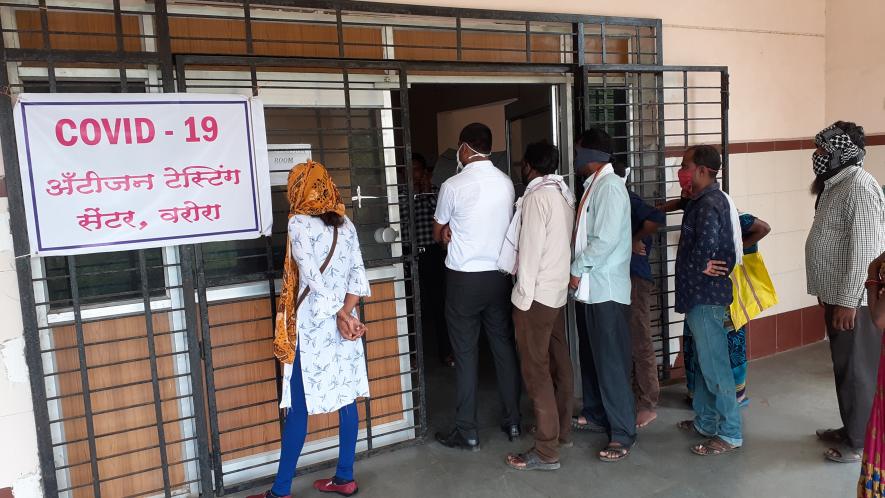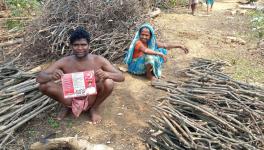We’ll be Reaching 4-5 Lakh COVID Cases Per Day in 5 States: Giridhar R Babu

Representational image. | Image Courtesy: Wikimedia Commons
Having allowed the COVID-19 virus to rampage unchecked across the country, it is now mutating into different variants that are likely to infect millions of Indians. Prof Giridhar R Babu, heading the epidemiology section at the Public Health Foundation, in an interview with NewsClick, gives a grim warning that cases of the coronavirus and its mutant strains will rise between six to ten lakh every day in the coming weeks. Aggressive containment is the only way to contain this virus. Edited excerpts:
RS: India’s COVID-19 active cases have crossed the three-and-a-half lakh figure in one day. In your epidemiological study conducted across 12 states, you had emphasised that in five states – Uttar Pradesh, Madhya Pradesh, Bihar, Chhattisgarh and West Bengal -- your mathematical models, are predicting that each of these states would cross the one lakh per day per state two weeks from now. What do these figures indicate?
GB: We are inching toward higher and higher numbers and in the next two weeks, I believe, we will be reaching between four to five lakh cases per day in these five states.
Looking at these figures, I am worried about the proportion from these which will be serious and will require oxygen support. If we assume that only 5% of these total cases (are serious), it would require a lot more beds and oxygen support than what we have the capacity to provide even in our metros. The situation will become even more difficult if the virus moves to rural areas where health infrastructure is poor.
What will happen if the virus moves to rural areas?
In rural areas, the problem will be severe in places where population density is higher, because the infection will spread to more people. If the population density is sparse, the number of cases will be fewer and infection will take a longer time to spread.
In places like Bihar and UP, where the auxiliary health system is a problem, this will be a major challenge compounded by the fact that the data systems there are not strong and are not able to capture the exact number of deaths.
Such a situation will further worsen access to healthcare, thereby further worsening inequities. The situation will worsen for people with vulnerabilities and from low socio-economic backgrounds. They will be the worst sufferers.
Inequities are already worsening. You mentioned your study was spread over 12 states, but the five cow belt states will be the worst affected...
The state of UP should have had more cases if testing was alright but they are still with 28,000 cases per day. The same is the case with Bihar, where also they have 7,487 cases of infection per day. Under-testing is a big issue. You cannot explain why Maharashtra has 58,000 cases per day, Delhi has 23,000 cases per day but if you put the entire state of UP together, they have only 28,000 cases.
If you look at the effective reproductive number, Maharashtra figure is 1.13, UP has 2.27, so the figure of infection cases here should be higher, Bihar has 2.49 so the cases should be higher. There is some problem of testing in these states.
Recently, The Economic Times carried a report that the UP chief minister has banned all private labs from testing, in UP or at least in Lucknow. This is the feedback I got from people living there?
There is a problem of testing. I am not sure about what orders have been given by the government but there is a major problem of testing in these states, which is obvious in the numbers. If we see the entire belt of MP, UP, Bihar and West Bengal, they all need to ramp up their testing facilities.
How much time would this take?
This has also got to do with people not wanting to get tested. People are scared to report their illness. They feel if they report, it will go into the health system and they will end up getting into trouble with the government. But this has to change to ensure transparency of data. This is a major issue in these states.
But state governments also do not want data transparency?
We need to question these state governments more closely. If the pandemic is surging across all these states and if these are not reporting the right data, the question to ask them is, why are they not doing adequate testing?
The focus will be on those states that report higher cases, which will end up getting more resources, thereby being able to prevent more deaths. If you don’t report, it will go against the poor people in these states?
That is precisely what is happening. What is the situation like in Karnataka and Tamil Nadu?
If we look at Tamil Nadu, as of now, they are reporting 10,000 cases per day. Their reproductive number is around 1.64.
Is the rising number of cases being caused by mutations of the virus?
Mostly yes. There is a strong possibility of there being several Indian mutants. We have to look at the data very carefully. One double mutant has been identified in Maharashtra. A triple mutant has been identified in West Bengal.
A triple mutant?
Yes, a triple mutant is when the virus has mutated three times over making it more infectious. One mutant has been identified in Bangalore by the National Institute of Mental Health and Neuro Sciences. It has not been classified as a variant of concern.
Triple mutants will only worsen the situation. This is very alarming, especially for the common man?
These reported variants are a matter of concern. If we do cluster investigations in a more number of samples, we may find more variants.
Who is doing these cluster investigations?
There is a consortium called the National Consortium for Genomic Sequencing working with IDSC.
But this genome sequencing is a fairly recent phenomenon. Shouldn’t this have started much earlier?
They did start earlier but it was not scaled up. Now they have scaled up.
Do you think we have bungled on the gains we had made from controlling the virus last year? We have become number one in the world.
A second wave all over the world is known to increase faster, the peak is much higher. Given our population, the impact will be higher in absolute numbers.
In hindsight, we should have ramped up our health system. But no health system anywhere in the world could have handled such a surge in cases. In both Karnataka and Tamil Nadu, oxygenated beds have been increased three times over after the first wave, but this time round, the cases have gone up 10 times over. How can any health system prepare for a ten-fold increase.
Other countries have also gone through these waves. Look at Lombardy in Italy and other such cities across the world. We are going through the same experience.
But their first wave hit the older population unlike what is happening in India where people across all segments of the population are being affected?
Based on data shared by the Ministry of Health in April 22 2021, even now mortality is higher in the 70 plus age group, who continued to suffer the highest mortality.
The strike rate this time is affecting children as also the 40 plus population?
It is affecting all the age groups. Proportion of age group being affected is the same, except the age group of 0 to 10 is higher.
As a doctor, what do you have to say given the present circumstances?
Our health systems had several inherent weaknesses. But no health system can be rebuilt in such a short span of time. Even where it was rebuilt, it was not sufficient to cater to such a rise in numbers.
Can you still rule out complacency on the part of the government following the waning of the first wave?
No one can rule out complacency. This is not the time to go into that. Some months ago, we saw doctors ruling out a second wave. Celebrations were taking place because COVID-19 was behind us.
Given the rising number of new cases, what is the death rate we are looking at?
The death rate has not changed much. It is around 1%. If there are one lakh cases, we will see around 1,000 deaths, five lakh cases means 5,000 deaths. But the deaths will not be on the same day. They will show up after two weeks. If there are five lakh cases, some will get admitted into intensive care, the deaths will begin to show up later.
Cremation grounds will find it difficult to cope...
As we move ahead, there will be even more problems. It is a hugely depressing scenario.
What steps can be immediately taken by the government and the public to stop the spread of the virus?
Wherever there is high transmission going on, we must reduce the number of cases. Street-level lockdown, city- level lockdown etc., we need aggressive containment. The variants are emerging from high circulation areas. More people having cases, means more variants. We have to start identifying these cases at the earliest and isolate those who have the infection. That is the only way forward.
Rashme Sehgal is a freelance journalist.
Get the latest reports & analysis with people's perspective on Protests, movements & deep analytical videos, discussions of the current affairs in your Telegram app. Subscribe to NewsClick's Telegram channel & get Real-Time updates on stories, as they get published on our website.
























